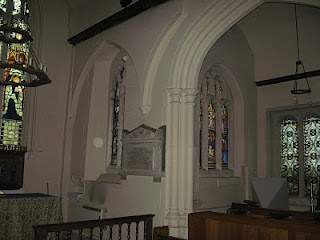St Katharine's Church is just to the north of Merstham village on gently sloping Downland and adjacent to the present line of the A23 road. It is predominantly thirteenth century and comprises a nave of three bays, chancel, north and south chapels, north and south aisles, choir and clergy vestries, south porch, and west tower.
An original small wooden church is believed to have been completed on the site around 1100, after the first Crusade. The donor of most of the money, no doubt a Crusader himself, seems to have insisted upon its dedication to Saint Katharine of Alexandria (whose feast of title falls on 25th November).
She was the daughter of King Constus of Alexandria and is believed to have been betrothed to a 'lesser' king of Britain. Her mother was secretly a Christian and Katherine was exceptionally well educated in Greek philosophy, medicine, rhetoric and logic. When the Emperor Maxentius offered sacrifice to idols and ordered everyone to do the same, Katharine denounced him. Furious, he sent scholars to argue with her; but she refuted them, remaining steadfast to her Christian faith. Katharine was imprisoned, tortured and later executed. It is recorded that 51 churches in England were dedicated to the saint, after the crusaders had returned home bringing news of the early saints and martyrs.
This church lasted less than 150 years and by about 1220 was replaced by a new Early English Church. The church, which still stands today is made almost entirely of the greyish-green Merstham stone. Unfortunately the stone is starting to deteriorate, hence the scaffold.
The tower is thirteenth century, the centre arch of the which is rumored to be built from the old London Bridge. The spire, which is octagonal, was added in the 14th century and contains much of the original timberwork. It was completely re-shingled in 1981.

 The south porch fourteenth century; in the gable over it is an eighteenth century sundial. Much of the masonry of this door was renewed in 1931, and the sundial entirely refaced.
The south porch fourteenth century; in the gable over it is an eighteenth century sundial. Much of the masonry of this door was renewed in 1931, and the sundial entirely refaced.The Sussex marble font dates from c1150 and is one of the few objects remaining from the original church. It is ornamented on three sides with a rude arcade motif, which suggests that it was originally set against a wall. The four corners of the bowl are ornamented with a trefoil leaf carving representing the Trinity.

 On the south side of the altar is a double piscinae set under a shouldered arch with (according to the guidebook) ‘beautiful still leaf carving below the bowls’. Double piscinae were introduced by order of Pope Innocent in the early part of the thirteenth century, and discontinued before the beginning of the fourteenth.
On the south side of the altar is a double piscinae set under a shouldered arch with (according to the guidebook) ‘beautiful still leaf carving below the bowls’. Double piscinae were introduced by order of Pope Innocent in the early part of the thirteenth century, and discontinued before the beginning of the fourteenth.Before the formation of the chantry chapels the walls of the chancel were decorated with an arcade of three bays on either side. These extended the full height and presented a constructional arcade of high pointed early English arches resting on shafts and occupying the whole of the side walls. This is an unusual feature and found only in a few churches in the southeast counties, which gives strong evidence that they are the work of one architect.
The north chantry (the Albury Chapel) and the south chantry (the Alderstead chapel)were originally private chapels intended for the saying of Mass for the repose of the souls of the families who owned them, and were therefore divided from the church by wooden screens. Both are 15th century work. The picture below is taken from the chancel looking into the south chantry. Note the chantry arcades which end with segments of arches. No definite reason for this feature is known, but they were probably built to allow the rood-loft to continue right across the church.

The church was once decorated with mediaeval wall paintings, among them the story of St Katharine’s death by martyrdom. All that remains now is a cross “pateée”, a small consecration cross, on the west column of the north aisle dating from about 1200.


The lychgate on the west of the main road was erected in 1897 and is made from the oak of the old parish windmill, which stood on Rockshaw Road and was pulled down when the Brighton railway line was built.
No comments:
Post a Comment